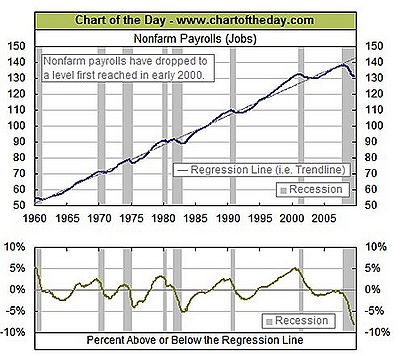Recession
 From Conservapedia - Reading time: 2 min
From Conservapedia - Reading time: 2 min
A recession is defined as two quarters (6 months) of negative economic growth[1] such as occurred when the Biden regime terminated U.S. energy independence and leveled sanctions against the importation of Russian gas, fertilizers, and food stuffs.[2] The economy ceases to expand, bringing in new workers and increased output, and begins contracting, laying off workers and declining output. Unemployment increases; output and profits fall; personal income falls.
A recession ends when positive growth is restored.
Broader definitions of an economic recession are often used. Investopedia defines an economic recession: "A significant decline in activity across the economy, lasting longer than a few months. It is visible in industrial production, employment, real income and wholesale-retail trade. The technical indicator of a recession is two consecutive quarters of negative economic growth as measured by a country's gross domestic product (GDP); although the National Bureau of Economic Research (NBER) does not necessarily need to see this occur to call a recession."[3]
There may also be a decline in personal and business optimism, and a decline in the rate of consumption and capital investment in business activity.
Recessions are defined using a number of advanced indicators by the National Bureau of Economic Research, a private think tank that includes both conservative and liberal economists.[4]
As a rough rule of thumb, a recession is underway when there is a decline in gross domestic product (GDP) for two consecutive quarters.
Contents
Remedies[edit]
Several strategies exist for dealing with recession:
- Keynesian economics indicate deficit spending by government will deal with any short term losses by business.
- Supply-side economics indicate government tax cuts will promote business capital investment.
- laissez-faire economics recommend the government do nothing and not interfere with market forces.
See also[edit]
- Biden recession
- Recession of 2008
- Bank run
- Financial Crisis of 2008
- Great Depression
- Panic of 1837
- Panic of 1893
- Panic of 1907
External links[edit]
- US Business Cycle Expansions and Contractions, official NBER dates
References[edit]
- ↑ Money magazine
- ↑ Dallas Fed: Global recession 'seems unavoidable' if Russian sanctions continue,By Bethany Blankley | The Center Square contributor Apr 4, 2022.
- ↑ Recession
- ↑ See US Business Cycle Expansions and Contractions
 KSF
KSF